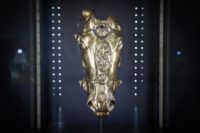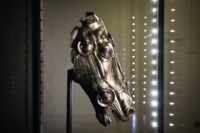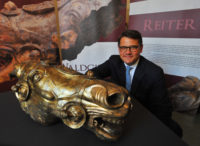The gilded bronze horse head from a 1st century equestrian statue found in Waldgirmes, central Germany, is going on public display for the first time since it was unearthed in 2009. It’s been through a lot in its 2000 years, first getting dismembered by Germanic tribesmen making a point about the transitory nature of imperial power in the wake of their annihilation of Rome’s legions at the Battle of Teutoborg Forest, then getting thrown in a deep well, then getting dug up by archaeologists, then spending years undergoing painstaking conservation while the owner of the land where it was found took the state of Hesse to court to geometrically expand his compensation.
 When I posted last month about the outcome of the trial (the court sided with the landowner), there were no recent photos of the horse’s head so I had to grudgingly make do with one taken in 2010 in the early stages of conservation. Very grudgingly. Most extremely grudgingly. All that gnashing of teeth can now be forgotten because Hesse has finally put the horse head on public display. The new exhibition opens Sunday and was previewed for the press on Friday. That means those of us not afforded the opportunity to see the gloriously golden equine in person benefit from the release of new photographs of it on display.
When I posted last month about the outcome of the trial (the court sided with the landowner), there were no recent photos of the horse’s head so I had to grudgingly make do with one taken in 2010 in the early stages of conservation. Very grudgingly. Most extremely grudgingly. All that gnashing of teeth can now be forgotten because Hesse has finally put the horse head on public display. The new exhibition opens Sunday and was previewed for the press on Friday. That means those of us not afforded the opportunity to see the gloriously golden equine in person benefit from the release of new photographs of it on display.
The Saalburg Roman Fort museum is the lucky recipient of the refreshed head. Built in the early 2nd century A.D. under the reign of the Emperor Trajan, the fort overlooking the Limes (the frontier of the Roman Empire) did sentry duty for 150 years before the frontier got too hot and the troops were withdrawn. The ruins of the Saalburg were rediscovered and excavated in the mid-19th century. Between 1897 and 1907, the fort was reconstructed by order of Kaiser Wilhelm II. It became an open-air museum and research facility surrounded by the remains of the Roman settlement which was also partially reconstructed. Today it is the only museum in Hesse that is entirely dedicated to the area’s Roman history.
 Saalburg’s permanent exhibition has been updated and redesigned over the past few years, and the Waldgirmes head will be its centerpiece. The museum has created a wall-height poster depicting the original size of the full statue. The head alone is two feet long and weighs 33 pounds, so the statue was an impressive sight when it was intact. Another large panel explains how the horse head was excavated from a wooden barrel at the bottom of well shaft 36 feet deep.
Saalburg’s permanent exhibition has been updated and redesigned over the past few years, and the Waldgirmes head will be its centerpiece. The museum has created a wall-height poster depicting the original size of the full statue. The head alone is two feet long and weighs 33 pounds, so the statue was an impressive sight when it was intact. Another large panel explains how the horse head was excavated from a wooden barrel at the bottom of well shaft 36 feet deep.
That was just the beginning of the hard work. While the waterlogged anaerobic environment preserved the gilded bronze head, it did have some thorny condition issues mostly posed by the nature of gilding itself. The corrosion of the bronze manifested on the gold surface which, as on any gilded object, is extremely thin. Conservators struggled to remove those corrosion products without also removing precious gold. Patches of acrylic resin were applied to strengthen a few areas and then the entire piece was given a coating of resin for its protection. The conservation team made a conscious choice not to re-gild areas of loss.
 Hesse’s Science and Arts Minister Boris Rhein showered the conservators with praise at the press preview of the exhibition, noting that their precision work allows us to see the exquisitely life-like details captured by the sculptor. The anatomy of the horse — muscles, veins, nostrils, teeth, eyes — is crafted with a verisimilitude only a highly skilled craftsman and artist could achieve.
Hesse’s Science and Arts Minister Boris Rhein showered the conservators with praise at the press preview of the exhibition, noting that their precision work allows us to see the exquisitely life-like details captured by the sculptor. The anatomy of the horse — muscles, veins, nostrils, teeth, eyes — is crafted with a verisimilitude only a highly skilled craftsman and artist could achieve.